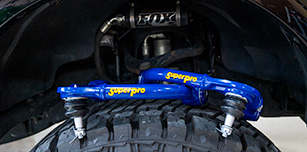- Nissan’s VR30DDTT is a twin-turbocharged, direct-injection 3.0-liter engine with factory output ranging from 300–400 hp.
- Because the Infiniti Q50/Q60 Red Sport’s engine bay is crammed full of various items, heat soak becomes a common issue in modified examples.
- Mishimoto’s performance heat exchanger for the Infiniti Q50/Q60 puts R&D into fruition, lowering charge air temps.
We’re reliving the ’80s at the moment. The wild hair, the vibrant dress code, the eco-conscious automakers producing vehicles with smaller displacement engines, and the re-introduction of factory turbochargers to make up for the power loss — woo! This movement is excellent news for the aftermarket industry because if there’s one thing we enthusiasts love, it’s simple boost adjustments on turbo vehicles to make more power. An unfortunate byproduct of these fun turbochargers is excess heat. When Nissan released the twin-turbocharged VR30DDTT engine in the Infiniti Q50 and Q60, modifying enthusiasts realized heat soak was their adversary. Fear not, aftermarket cooling leader Mishimoto’s performance heat exchanger came in to cool things off.
WHAT IS THE VR30DDTT ENGINE?
Those excited about the new 2022 Nissan Z release will recognize the engine code straight away, as it resides in the new sports coupe. For anyone else, the VR30DDTT is Nissan’s aluminum 3.0-liter twin-turbocharged V6 engine with direct injection. It was first released in the 2016 Infiniti Q50, then became the de facto engine choice for the Q60 the following year. It’s known for its high factory output of 300–400HP, a robust statistic for any avid driver. The aftermarket has already responded well to this new-age powerplant, but with the 2022 Nissan Z housing the very same propulsion, it’s about to get a lot more attention.
DOES THE VR30DDTT HAVE ANY DRAWBACKS?
It sure does. Namely, the excess heat that two turbochargers crammed next to a V6 engine will generate in the typical filled-to-the-brim Nissan engine bay. Nissan does a decent job of remedying this downfall by equipping it with two large air-to-water intercoolers, but now we’re introducing a secondary radiator into the mix — also known as a heat exchanger. While the system does a good enough job for the average owner, the weak point in the cooling system becomes the heat exchanger once modifications are introduced. Such is the case on the subject of today’s article, this 2019 Infiniti Q50 Red Sport.
WHY DOES THE FACTORY UNIT NEED TO BE REPLACED?
First of all, the stock piece from Nissan is pretty lacking in size. Judging by the amount of space available in the engine bay (which isn’t much), Nissan did what they could, but it’s just tiny. As boost is increased and more heat needs to be dissipated, the size of the factory unit struggles to keep up.
Also, the team of Mishimoto engineers determined that the plastic end tanks of anything in the cooling system are sure to become an issue. As we learned on the F80 M3, the constant temperature changes experienced in an engine bay (especially one in the alternating climate of the northeastern United States) challenge the plastic material’s integrity and eventually lead to failure. So, replacement should be on any Q50/Q60 owner’s to-do list.
MISHIMOTO’S PERFORMANCE HEAT EXCHANGER
With complete aluminum construction, TIG-welded end tanks, a 196-percent increase in core volume, and a 97-percent increase in external fin surface area, Mishimoto’s solution checks all of the boxes to remedy the stock piece’s shortcomings. It will drop heat exchanger temperatures up to 21ºF over the stock Nissan piece. Its increased size is a tight fit, but Mishimoto engineered it to utilize every ounce of spare room available.
THE THREE-HOUR INSTALLATION PROCESS
While this is not beyond the realm of any weekend garage job, it is relatively involved. It requires the disassembly of a large portion of the front end (including the bumper and passenger side headlight housing), the removal of the intake airboxes, the oil cooler, fender liners, and the front crash beam support structure. Not to mention the special airlift coolant refill tool required for priming the electric coolant pumps in the intercooler system after the install is complete.
However, if you’re proficient with disassembly and reassembly like the team is at R/T Tuning in Montgomeryville, PA, then you’ve got nothing to worry about. They first removed the items listed above, then clamped off the coolant hoses to prevent excess coolant leakage. From there, it was a matter of removing the old factory unit and sliding the new aluminum Mishimoto replacement into its spot.
Once R/T Tuning reinstalled the ancillaries, they opted to pour some fresh Mishimoto Liquid Chill into the charge air cooler’s coolant reservoir (with the airlift tool) and began the bleeding process. With everything completed, they took the car on a short test drive, allowed it to cool down, and checked all fluid levels for a final time.
This heat exchanger isn’t a modification that ups the horsepower mark. It has a small chance of winning any show points positioned behind the bumper. It doesn’t increase turbo response, and it won’t make your car lower or chicer. However, it is a workhorse lurking in the shadows to bring down charge air (intercooler) temps so that your twin-turbocharged Infiniti can keep running at its peak without any larger issues presenting themselves, and that’s significantly more important!



















